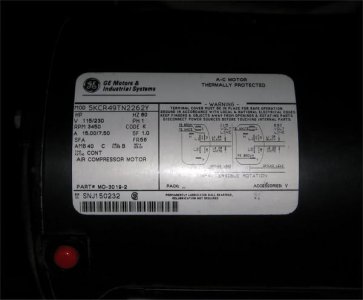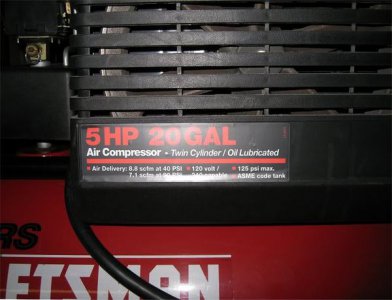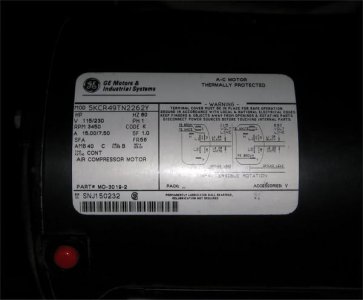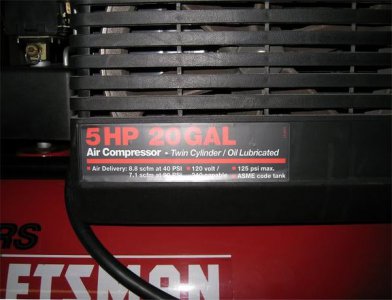-
Welcome back Guest! Did you know you can mentor other members here at H-M? If not, please check out our Relaunch of Hobby Machinist Mentoring Program!
- Forums
- GENERAL TYPES OF METALWORKING MACHINES
- ANTIQUE & VINTAGE MACHINERY
- MISC ANTIQUE & VINTAGE MACHINERY
You are using an out of date browser. It may not display this or other websites correctly.
You should upgrade or use an alternative browser.
You should upgrade or use an alternative browser.
HF 4x6 bandsaw - universal or induction motor?
- Thread starter joe_m
- Start date
- Joined
- Nov 16, 2012
- Messages
- 5,596
Steve,
Marketing plays games with HP ratings. My air compressor also claims to be 5HP. -No way. It pulls 18 amps steady-state which is about 3HP so, I'm guessing the initial current draw (which is probably 2-3 times steady state) mathematically puts it in the 5 HP range -for about 3 seconds.
No matter how you slice it, efficiency is rated as output / input. If a motor is mechanically putting out 1 HP it must be supplied at least 1 hp + power to overcome inefficiency (friction and heat losses etc). If a 1 HP motor needs 16A, it's very inefficient -but possibly that inefficiency helps it obtain a higher service rating (i.e. it has a massive rotor with a lot of inertia). -Don't know, it's been 30 years since I studied that stuff and much of it was electromagnetism and the math behind it.
220 motors of the same HP pull the same amps but, the current is spread across another wire (they have 2 circuits of 110). Each circuit carries half the load so, the breaker on each circuit is less likely to trip.
When you run extension cords, there are electrical (resistance) losses in the long wire which consume power along with the motor at the end of the wire. The circuit breaker doesn't care, it just knows too much current is being pulled so it trips. Sometimes it doesn't trip right away because it takes a while for the extension cord to heat up. Generally speaking, resistance increases as temps get higher.
And finally, yes, motors are inductive loads causing the current and voltage to be out of synch. This is why some motors have a Run Capacitor. Capacitors are opposite of inductors so, adding a capacitor normalizes the power factor. When the power factor in a line gets too high, it causes problems with the electrical meter and can cause problems with other appliances. And finally, there are start capacitors... When a motor has a start cap, it has two sets of windings and the cap is only connected to one of the windings (the start windings). The cap causes one of the windings to oppose the field in the other winding because, some designs of motors need an initial counter-torque to get them spinning. There is also a centrifugal switch so once the motor gets up to speed, the start winding and cap are switched out.
There..... Motors 101. At one time in my life, I probably knew the details of about 5-6 types of motors but, now, I just care how much they weigh, how often I have to move them -and if they work good or not.
EDIT: When a 220 line is wired, one circuit must come from one tap off the breaker panel and the the other circuit comes off the other tap. The taps are 180 degrees out of phase (i.e. as one is high, the other is low). You cannot take two 110 lines from the same tap to power a 220 motor.
if 1hp at 110v needs 16 amps how does my old craftsman 110v air compressor with a 5hp motor run on my 20 amp breaker? would that not need 80 amps with this math
i'm not trying to be a smart a.. i'm curious
steve[/QUOTE]
Marketing plays games with HP ratings. My air compressor also claims to be 5HP. -No way. It pulls 18 amps steady-state which is about 3HP so, I'm guessing the initial current draw (which is probably 2-3 times steady state) mathematically puts it in the 5 HP range -for about 3 seconds.
No matter how you slice it, efficiency is rated as output / input. If a motor is mechanically putting out 1 HP it must be supplied at least 1 hp + power to overcome inefficiency (friction and heat losses etc). If a 1 HP motor needs 16A, it's very inefficient -but possibly that inefficiency helps it obtain a higher service rating (i.e. it has a massive rotor with a lot of inertia). -Don't know, it's been 30 years since I studied that stuff and much of it was electromagnetism and the math behind it.
220 motors of the same HP pull the same amps but, the current is spread across another wire (they have 2 circuits of 110). Each circuit carries half the load so, the breaker on each circuit is less likely to trip.
When you run extension cords, there are electrical (resistance) losses in the long wire which consume power along with the motor at the end of the wire. The circuit breaker doesn't care, it just knows too much current is being pulled so it trips. Sometimes it doesn't trip right away because it takes a while for the extension cord to heat up. Generally speaking, resistance increases as temps get higher.
And finally, yes, motors are inductive loads causing the current and voltage to be out of synch. This is why some motors have a Run Capacitor. Capacitors are opposite of inductors so, adding a capacitor normalizes the power factor. When the power factor in a line gets too high, it causes problems with the electrical meter and can cause problems with other appliances. And finally, there are start capacitors... When a motor has a start cap, it has two sets of windings and the cap is only connected to one of the windings (the start windings). The cap causes one of the windings to oppose the field in the other winding because, some designs of motors need an initial counter-torque to get them spinning. There is also a centrifugal switch so once the motor gets up to speed, the start winding and cap are switched out.
There..... Motors 101. At one time in my life, I probably knew the details of about 5-6 types of motors but, now, I just care how much they weigh, how often I have to move them -and if they work good or not.
EDIT: When a 220 line is wired, one circuit must come from one tap off the breaker panel and the the other circuit comes off the other tap. The taps are 180 degrees out of phase (i.e. as one is high, the other is low). You cannot take two 110 lines from the same tap to power a 220 motor.
Typical FLA (full load amps at rated shaft power) for a 1 HP motor is around 16 amps.
6.4 FLA amps on the Harbor Ft motor gets you between 1/4 and 1/3 HP on the shaft (and a little less than that after you go through the gear box).
Terry S
if 1hp at 110v needs 16 amps how does my old craftsman 110v air compressor with a 5hp motor run on my 20 amp breaker? would that not need 80 amps with this math
i'm not trying to be a smart a.. i'm curious
steve[/QUOTE]
Last edited:
- Joined
- Nov 16, 2012
- Messages
- 5,596
Oh my heavens... ...It makes me wonder what would happen if you plugged-in one of those handy pocket circuit testers -you know, the ones with the LEDs that tells if the outlet is wired properly. -It would probably get confused and blow up. Glad nobody got shocked.
No, same rating. I don't think it would start if it was wired 220v and plugged into 110v.
That reminds me of a funny story, well not really funny, but odd.
I had a friend that moved into an old house. I dropped by to see it and he told me he had a problem with one outlet. It only worked if two things were plugged into it. I took the cover off and checked. Somebody had wired it with a 220v circuit so the outlets were wired in series. The current went in one outlet and out the other, so to speak, so it provided 110v to each plug. I'm glad he only had lamps plugged into it.
- Joined
- Nov 27, 2012
- Messages
- 7,912
you are right it cant be 5 hp on 110v, but it can be wired for 220 could it have a different winding/rating for wiring at 110v?
now i'm going to look for the motor tag tomorrow. i'll bet i'm wrong and it is 2hp
steve
Steve,
Marketing plays games with HP ratings. My air compressor also claims to be 5HP. -No way. It pulls 18 amps steady-state which is about 3HP so, I'm guessing the initial current draw (which is probably 2-3 times steady state) mathematically puts it in the 5 HP range -for about 3 seconds.
steve
Agreed, it was all marketing. That 5HP rating was peak HP which is useless as it wouldn't even run at that for a few seconds. At some point (only some years ago), there was some kind of case against air compressor suppliers that required them to stop marketing peak HP.
You've probably noticed that Craftsman (& others) no longer sell "5HP" 110V compressors. I'm not sure how old your Craftsman air compressor is but I had a Craftsman (made by DevilBiss) that was made in 1998 & was labeled 5HP (as mentioned by someone, 220V doesn't make it more powerful). Even to this day when ever I stop by Sears & look at the air compressors, I'll still see a version of my air compressor but never labeled as 5HP any more. More like 1.5-2HP.
Here's the motor tag from that "5HP" compressor




- Joined
- Jan 22, 2011
- Messages
- 8,032
I think that was a class action against the mfg companies. It was supposedly calculated by using the stall load, which is basically the LRA, totally unfair way to advertise.
